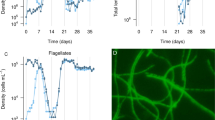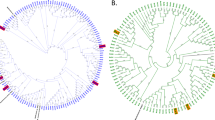Abstract
Community dynamics are often studied in subsets of pairwise interactions. Scaling pairwise interactions back to the community level is, however, problematic because one given interaction might not reflect ecological and evolutionary outcomes of other functionally similar species interactions or capture the emergent eco-evolutionary dynamics arising only in more complex communities. Here we studied this experimentally by exposing Pseudomonas fluorescens SBW25 prey bacterium to four different protist predators (Tetrahymena pyriformis, Tetrahymena vorax, Chilomonas paramecium and Acanthamoeba polyphaga) in all possible single-predator, two-predator and four-predator communities for hundreds of prey generations covering both ecological and evolutionary timescales. We found that only T. pyriformis selected for prey defence in single-predator communities. Although T. pyriformis selection was constrained in the presence of the intraguild predator, T. vorax, T. pyriformis selection led to evolution of specialised prey defence strategies in the presence of C. paramecium or A. polyphaga. At the ecological level, adapted prey populations were phenotypically more diverse, less stable and less productive compared with non-adapted prey populations. These results suggest that predator community composition affects the relative importance of ecological and evolutionary processes and can crucially determine when rapid evolution has the potential to change ecological properties of microbial communities.
Similar content being viewed by others
Log in or create a free account to read this content
Gain free access to this article, as well as selected content from this journal and more on nature.com
or
References
Abrams PA . (2000). The evolution of predator-prey interactions: theory and evidence. Annu Rev Ecol Syst 31: 79–105.
Banerji A, Morin PJ . (2009). Phenotypic plasticity, intraguild predation and anti-cannibal defences in an enigmatic polymorphic ciliate. Funct Ecol 23: 427–434.
Becks L, Ellner SP, Jones LE, Hairston NG Jr . (2010). Reduction of adaptive genetic diversity radically alters eco-evolutionary community dynamics. Ecol Lett 13: 989–997.
Berenbaum MR, Zangerl AR . (2006). Parsnip webworms and host plants at home and abroad: trophic complexity in a geographic mosaic. Ecology 87: 3070–3081.
Billick I, Case TJ . (1994). Higher-order interactions in ecological communities - what are they and how can they be detected. Ecology 75: 1529–1543.
Brunk CF, Lee LC, Tran AB, Li JL . (2003). Complete sequence of the mitochondrial genome of Tetrahymena thermophila and comparative methods for identifying highly divergent genes. Nucleic Acids Res 31: 1673–1682.
Craig TP, Itami JK, Horner JD . (2007). Geographic variation in the evolution and coevolution of a tritrophic interaction. Evolution 61: 1137–1152.
Davies NB, Brooke MDL . (1989). An experimental study of co-evolution between the cuckoo, Cuculus canorus, and its hosts. I. Host egg discrimination. J Anim Ecol 58: 207–224.
Edeline E, Ben Ari T, Vollestad LA, Winfield IJ, Fletcher JM, Ben James J et al. (2008). Antagonistic selection from predators and pathogens alters food-web structure. PNAS 105: 19792–19796.
Elliott AM . (1959). Biology of Tetrahymena. Annu Rev Microbiol 13: 79–96.
Ellner SP, Becks L . (2011). Rapid prey evolution and the dynamics of two-predator food webs. Theor Ecol 4: 133–152.
Flynn KM, Cooper TF, Moore FB, Cooper VS . (2013). The environment affects epistatic interactions to alter the topology of an empirical fitness landscape. PLoS Genet 9: e1003426.
Fox LR . (1988). Diffuse coevolution within complex communities. Ecology 69: 906–907.
Friman V-P, Diggle SP, Buckling A . (2013). Protist predation can favour cooperation within bacterial species. Biol Lett 9: 20130548.
Friman V-P, Buckling A . (2014). Phages can constrain protist predation-driven attenuation of Pseudomonas aeruginosa virulence in multienemy communities. ISME J 8: 1820–1830.
Friman V-P, Guzman LM, Reuman DC, Bell T . (2015). Bacterial adaptation to sublethal antibiotic gradients can change the ecological properties of multitrophic microbial communities. Proc R Soc Lond B Biol Sci 282: 20142920.
Friman VP, Hiltunen T, Laakso J, Kaitala V . (2008). Availability of prey resources drives evolution of predator-prey interaction. Proc Biol Sci R Soc 275: 1625–1633.
Friman VP, Laakso J . (2011). Pulsed-resource dynamics constrain the evolution of predator-prey interactions. Am Nat 177: 334–345.
Friman VP, Buckling A . (2013). Effects of predation on real-time host-parasite coevolutionary dynamics. Ecol Lett 16: 39–46.
Friman VP, Jousset A, Buckling A . (2014). Rapid prey evolution can alter the structure of predator–prey communities. J Evol Biol 27: 374–380.
Futuyma DJ, Moreno G . (1988). The evolution of ecological specialization. Annu Rev Ecol Syst 19: 207–233.
Gomez JM, Perfectti F, Bosch J, Camacho JPM . (2009). A geographic selection mosaic in a generalized plant-pollinator-herbivore system. Ecol Monogr 79: 245–263.
Gronlien HK, Berg T, Lovlie AM . (2002). In the polymorphic ciliate Tetrahymena vorax, the non-selective phagocytosis seen in microstomes changes to a highly selective process in macrostomes. J Exp Biol 205: 2089–2097.
Hiltunen T, Jones LE, Ellner SP, Hairston NG . (2013). Temporal dynamics of a simple community with intraguild predation: an experimental test. Ecology 94: 773–779.
Hiltunen T, Becks L . (2014). Consumer co-evolution as an important component of the eco-evolutionary feedback. Nat Commun 5: 5226.
Iwao K, Rausher MD . (1997). Evolution of plant resistance to multiple herbivores: quantifying diffuse coevolution. Am Nat 149: 316–335.
Janzen DH . (1980). When is it coevolution. Evolution 34: 611–612.
Kim W, Racimo F, Schluter J, Levy SB, Foster KR . (2014). Importance of positioning for microbial evolution. PNAS 111: E1639–E1647.
Lawrence D, Fiegna F, Behrends V, Bundy JG, Phillimore AB, Bell T et al. (2012). Species interactions alter evolutionary responses to a novel environment. PLoS Biol 10: e1001330.
Matz C, Bergfeld T, Rice SA, Kjelleberg S . (2004). Microcolonies, quorum sensing and cytotoxicity determine the survival of Pseudomonas aeruginosa biofilms exposed to protozoan grazing. Environ Microbiol 6: 218–226.
Meyer JR, Kassen R . (2007). The effects of competition and predation on diversification in a model adaptive radiation. Nature 446: 432–435.
Mikonranta L, Friman VP, Laakso J . (2012). Life history trade-offs and relaxed selection can decrease bacterial virulence in environmental reservoirs. PLoS One 7: e43801.
Nuismer SL, Thompson JN . (2006). Coevolutionary alternation in antagonistic interactions. Evolution 60: 2207–2217.
O'Toole GA, Kolter R . (1998). Initiation of biofilm formation in Pseudomonas fluorescens WCS365 proceeds via multiple, convergent signalling pathways: a genetic analysis. Mol Microbiol 28: 449–461.
Parchman TL, Benkman CW . (2008). The geographic selection mosaic for ponderosa pine and crossbills: a tale of two squirrels. Evolution 62: 348–360.
Patterson DJ . (1996) Free-lIving Freshwater Protozoa: A Colour Guide. John Wiley & Sons: New York, NY, USA.
Popat R, Crusz SA, Messina M, Williams P, West SA, Diggle SP . (2012). Quorum-sensing and cheating in bacterial biofilms. Proc Biol Sci R Soc 279: 4765–4771.
Rainey PB, Bailey MJ . (1996). Physical and genetic map of the Pseudomonas fluorescens SBW25 chromosome. Mol Microbiol 19: 521–533.
Rainey PB, Travisano M . (1998). Adaptive radiation in a heterogeneous environment. Nature 394: 69–72.
Sih A, Englund G, Wooster D . (1998). Emergent impacts of multiple predators on prey. Trends Ecol Evol 13: 350–355.
Spiers AJ . (2014). A mechanistic explanation linking adaptive mutation, niche change, and fitness advantage for the wrinkly spreader. Int J Evol Biol 2014: 10.
Stinchcombe JR, Rausher MD . (2001). Diffuse selection on resistance to deer herbivory in the ivyleaf morning glory, Ipomoea hederacea. Am Nat 158: 376–388.
Strauss SY, Irwin RE . (2004). Ecological and evolutionary consequences of multispecies plant-animal interactions. Annu Rev Ecol Evol Syst 35: 435–466.
Strauss SY, Sahli H, Conner JK . (2005). Toward a more trait-centered approach to diffuse (co)evolution. New Phytol 165: 81–89.
Thompson JN, Cunningham BM . (2002). Geographic structure and dynamics of coevolutionary selection. Nature 417: 735–738.
Thompson JN . (2005) The Geographic Mosaic of Coevolution. University of Chicago Press: Chicago, IL, USA.
Vandermeer JH . (1969). The competitive structure of communities: an experimental approach with protozoa. Ecology 50: 362–371.
Yoshida T, Jones LE, Ellner SP, Fussmann GF, Hairston NG . (2003). Rapid evolution drives ecological dynamics in a predator-prey system. Nature 424: 303–306.
Acknowledgements
This study was funded by Imperial College Junior Research Fellow scheme (to V-PF), Grant-in-Aid funding from The Natural History Museum (to DJB), NHM-UCL PhD studentship (to AD) and the Royal Society and the Natural Environment Research Council (to TB).
Author contributions
V-PF, AD, DB and TB designed the study; AD and V-PF performed the research; VP-F wrote the first draft of the manuscript and all authors contributed substantially to revisions.
Author information
Authors and Affiliations
Corresponding author
Ethics declarations
Competing interests
The authors declare no conflict of interest.
Rights and permissions
About this article
Cite this article
Friman, VP., Dupont, A., Bass, D. et al. Relative importance of evolutionary dynamics depends on the composition of microbial predator–prey community. ISME J 10, 1352–1362 (2016). https://doi.org/10.1038/ismej.2015.217
Received:
Revised:
Accepted:
Published:
Issue date:
DOI: https://doi.org/10.1038/ismej.2015.217
This article is cited by
-
The genetic architecture underlying prey-dependent performance in a microbial predator
Nature Communications (2022)
-
Protist communities are more sensitive to nitrogen fertilization than other microorganisms in diverse agricultural soils
Microbiome (2019)
-
Phage combination therapies for bacterial wilt disease in tomato
Nature Biotechnology (2019)



